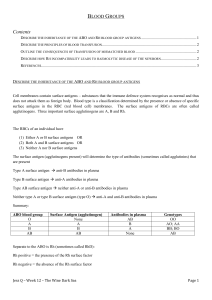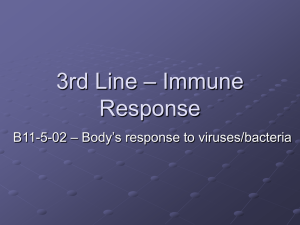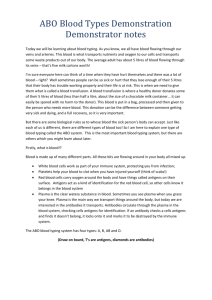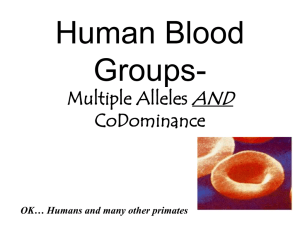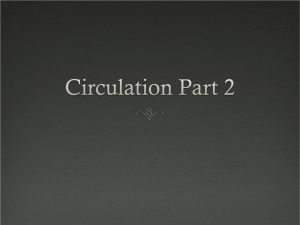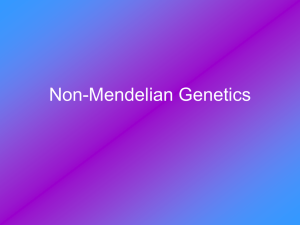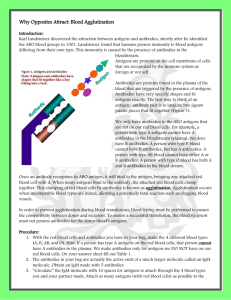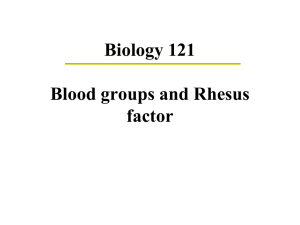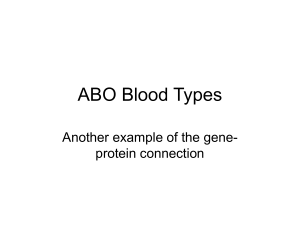BLOOD GROUPING
advertisement
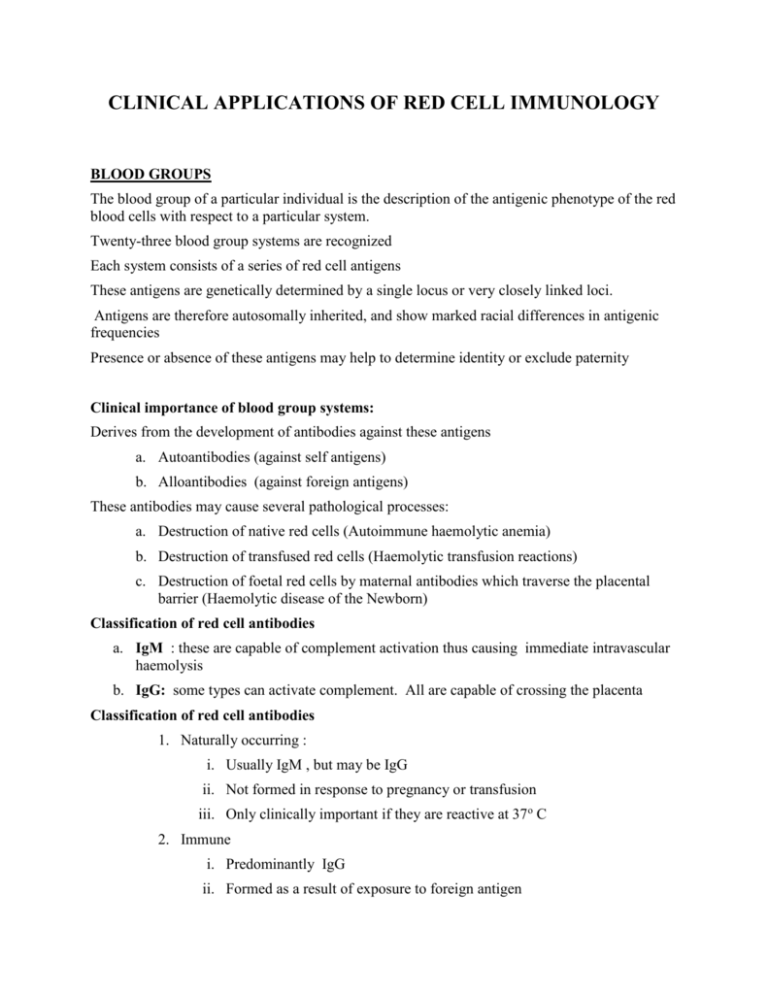
CLINICAL APPLICATIONS OF RED CELL IMMUNOLOGY BLOOD GROUPS The blood group of a particular individual is the description of the antigenic phenotype of the red blood cells with respect to a particular system. Twenty-three blood group systems are recognized Each system consists of a series of red cell antigens These antigens are genetically determined by a single locus or very closely linked loci. Antigens are therefore autosomally inherited, and show marked racial differences in antigenic frequencies Presence or absence of these antigens may help to determine identity or exclude paternity Clinical importance of blood group systems: Derives from the development of antibodies against these antigens a. Autoantibodies (against self antigens) b. Alloantibodies (against foreign antigens) These antibodies may cause several pathological processes: a. Destruction of native red cells (Autoimmune haemolytic anemia) b. Destruction of transfused red cells (Haemolytic transfusion reactions) c. Destruction of foetal red cells by maternal antibodies which traverse the placental barrier (Haemolytic disease of the Newborn) Classification of red cell antibodies a. IgM : these are capable of complement activation thus causing immediate intravascular haemolysis b. IgG: some types can activate complement. All are capable of crossing the placenta Classification of red cell antibodies 1. Naturally occurring : i. Usually IgM , but may be IgG ii. Not formed in response to pregnancy or transfusion iii. Only clinically important if they are reactive at 37o C 2. Immune i. Predominantly IgG ii. Formed as a result of exposure to foreign antigen Major blood group systems: 1. ABO - Within the ABO system four major blood groups can be recognized: Blood group A (A antigen on RBC + B antibody in plasma) Blood group B (B antigen on RBC + A antibody in plasma) Blood group AB (A and B antigens on rbc + No anti A or anti B antibodies in plasma) - Blood group O (No A nor B antigens on rbc + anti- A and B antibodies in plasma) ABO antibodies to antigens that are absent appear in first 3 months of life. 2.Rh(D) -Complex system comprising 45 different antigens - Five important antigens: D; C; E; e; c. Rh (D) +ve = Rh +ve Rh antibodies are IgG; most cannot fix complement 3. Others (Minor antigens) Numerous other antigens e.g Kell, Duffy, Kidd ( not usually tested routinely on donated blood) APPLICATIONS OF RBC IMMUNOLOGY 1.Blood Group Testing Usually restricted to the ABO and the Rhesus (D) A) ABO Blood Group To determine the ABO type, red cells must be tested with anti-A and Anti-B and the serum/plasma tested with A and B red cells Forward grouping - identifies the antigens on the red cells - tests the recipient or donor red cells with anti-A and anti-B sera eg Cells agglutinated only with anti-A serum are group A Cells that do not agglutinate with anti-A or anti-B are group O Reverse grouping – identifies the presence of antibodies in the serum/plasma - confirms the reaction obtained by the forward grouping test - tests the serum/plasma from the recipient or donor with group A red cells and group B red cells eg Agglutination with group B cells indicates the presence of anti-B in the plasma – Group A individual B) Rhesus Blood Group (Rh) Rhesus typing of red cells is determined by examining their reaction with anti-D serum. There are no ‘naturally- occurring' Rhesus antibodies, therefore reverse grouping is not performed. Routine testing for other Rh antigens is not required. 2.ANTIBODY SCREENING Naturally occurring antibodies occur in the plasma of individuals who lack the corresponding antigen and who have not been pregnant or transfused. The most important are anti-A and anti-B. These are usually IgM antibodies. Immune antibodies develop in response to the introduction of red cells possessing antigens the individual lacks. This may occur after pregnancy or previous blood transfusions. These antibodies are commonly IgG optimally react at 37 C. One example is anti-D. Detection of Immune Antibodies A) Direct Anti-globulin/Coombs test Aim: Detects antibody or complement on the red cell membrane Method: Dispense 1drop of red cell into a test tube Wash red cells 3-4 times with saline (To remove unattached antibodies) Decant final wash Add Coombs (antihuman globulin) reagent Centrifuge Examine for agglutination Interpretation: Agglutination indicates a positive test Uses: Hemolytic Disease of the Newborn (HDN) Autoimmune Hemolytic Anemia (AIHA) Drug-induced Immune Hemolytic Anemia Hemolytic transfusion reactions (HTR) Limitation: A negative test does not necessarily rule out the presence of immune antibodies B) Indirect anti-globulin/Coombs test Aim: Detects antibodies present in the plasma Method (2 stage procedure): 2 drops serum/plasma into test tube Add, 1 drop Group O red cells Incubate at 37 C Wash red cells with saline 3-4 times Decant final wash Method cont’d: Add Coombs (antihuman globulin) reagent Centrifuge Examine for agglutination Interpretation: Agglutination implies that the original serum contained an antibody Uses: AIHA HTR Routine antibody screening of recipient’s serum prior to transfusion 3. Pre transfusion testing (THE CROSS-MATCH) 1) Select a unit of donor blood that has the same ABO and Rhesus blood group as the recipient 2) A cross-match must be performed before transfusion of red cells, unless there is an urgent need for blood. Aims: Demonstrate ABO incompatibility between donor and recipient Detect and identify clinically significant immune antibodies in the plasma of the recipient that will react with donor red cell antigens 4. Investigation of haemolytic transfusion reactions Case Study 22 yr -old man with Aplastic anaemia , is on regular transfusions for the past 18 months. Transfused for severe anaemia ( Hb 4.5 g/dl )and is discharged from hospital Returns in 2 weeks with weakness and jaundice Hb is 5.2g/dl Clinical Diagnosis: Delayed Haemolytic Transfusion Reaction 1. Exposure to minor foreign antigen with previous transfusion 2. Formed IgG antibodies (Sensitzation) 3. Re-exposed to same foreign antigen with the most recent transfusion 4. Antibodies bind to transfused cells causing their destruction in the spleen Tests for confirming diagnosis 1. Indirect Coombs Test 2. Direct Coombs test In future, all blood for this patient must be tested for this minor antigen and only antigen negative blood may be used 5. Investigation of Neonatal jaundice Mrs. A is group O RH(D)–ve . She is in her 3rd pregnancy. Her husband is group O Rh(D) +ve . She delivers a 2.5 kg baby after 38 weeks of pregnancy The baby is severely jaundiced and has a Hb of 11.0 g/dl Clinical Diagnosis: HDN ( Rh Incompatibility) 1. Mrs A was exposed to Rh(D) antigen of her first or second child during pregnancy or delivery, and formed Rh(D) antibodies 2. These antibodies crossed the placenta during the 3rd pregnancy and were bound to Rh(D) antigens of the foetus 3. Foetal red cells with antibody were destroyed in the spleen Tests for confirming diagnosis 1. Indirect Coombs Test on maternal serum 2. Direct Coombs test on infants blood

